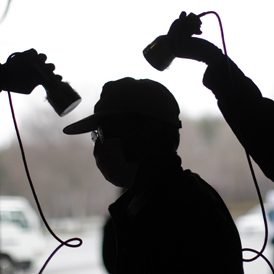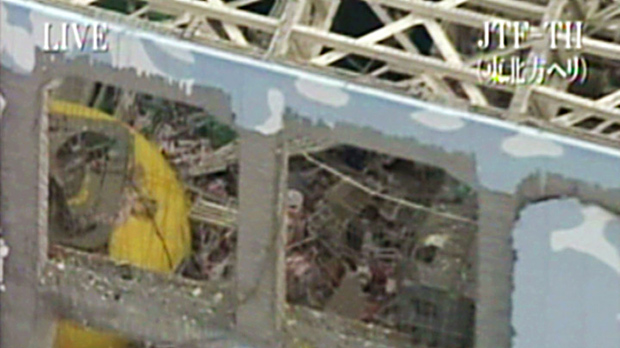Fukushima clean-up will take decades and cost billions
As the Japanese announce that four of the reactors at the stricken Fukushima nuclear plant will be decommissioned, an expert tells Channel 4 News the clean-up will take years and cost billions.
The operator of the Fukushima Daichi plant, Tokyo Electric Power (Tepco), confirmed that four of the six reactors will be shut down following the catastrophic nuclear accident at the plant sparked by the 11 March earthquake and tsunami in Japan. Locals will be consulted over decomissioning the other two reactors.
Following the explosions and attempts to cool the plants with seawater, the decommissioning was expected, but now opens up new questions about how it might work, how long it could take, and how much it may cost.

Malcolm Grimston, energy specialist at think tank Chatham House, told Channel 4 News that the process could take years and cost billions – but stressed the Japanese would be entering uncharted waters.
Whatever happens [at Fukushima], the answer is long and expensive. Nuclear expert Malcolm Grimston
“This is uncharted territory, a lot of new technology will be developed to deal with these reactors. The closest to this we have is Three Mile Island, where there was a partial core meltdown – I think about 40 per cent. The clean-up process lasted from 1979 to 1993, so almost 15 years, and cost £1bn. That was £1bn in 1993 money, so obviously a lot more now,” he said.
“Also now we have got four reactors damaged, not just a single one like at Three Mile Island, and the complicating factor of what state the spent fuel is in the ponds. At the moment there are huge imponderables, but whatever happens, the answer is long and expensive.”
Japan’s Chief Cabinet Secretary Yukio Edano agreed, telling a news conference: “We are not in a situation where we can say we will have this under control by a certain period.”
The Japanese authorities have also ordered an immediate safety upgrade at the 55 nuclear power plants across the country, including preparing back-up power supplies.
Leaks
However, Mr Grimston stressed that, while people were beginning to think about decommissioning and clean-up, engineers in Japan still faced a very real problem of cooling the reactors and preventing further leaks.
Earlier this week, plutonium was discovered in nearby soil, as well as highly radioactive waters in tunnels beneath the plant and in the sea. Extremely low levels of radiation have also spread globally, including to the UK.
“It is clear there is still a route for radioactive materials out of one of the reactors,” he said.
“The key thing is still getting water in to cool these reactors. There is still a risk of more problems – but the worst case scenario gets better every day.”
Read more in the Channel 4 News Special Report on Japan
This is because, as time passes, the radioactivity decays due to the half lives of the various materials, and the nuclear fuel inside the reactors cools, making explosions less likely.
Options
Mr Grimston said that there are two main options for decommissioning a nuclear plant – either removing the fuel to a storage or re-processing facility, or sealing up the plant in an “on site” solution.
Removing the fuel could be risky, he said, as there is no clear picture about the extent of the meltdown and fuel degradation.
“There will be a debate over whether the most sensible thing is to do like in Chernobyl, and build what’s called a sarcophagus around the reactor,” he said, meaning the site would be effectively encased in concrete.
The Cabinet Secretary said they were considering covering the reactor buildings with a special material to stop the radioactivity spreading.
“But it would have to be a socially acceptable as well as technological solution,” Mr Grimston pointed out.

Impact
The crisis at Fukushima has had a profound effect on Japan’s capacity to recover from the devastating tsunami and earthquake, not least financially.
Jesper Koll, director of equity research at JPMorgan Securities in Tokyo, said a drawn-out battle to bring the plant under control and manage the radioactivity being released would perpetuate the uncertainty and act as a further drag on the economy.
“The worst-case scenario is that this drags on not one month or two months or six months, but for two years, or indefinitely,” he said. “Japan will be bypassed. That is the real nightmare scenario.”
Japan’s main stock index has fallen about 9 percent since the tsunami while Tepco shares have fallen almost 80 percent. The Government is considering a tax hike to pay for the damage it estimates at $300 bn in what could be the world’s costliest natural disaster.
Read more: the Channel 4 News interactive video map of the Japan disaster
Around 27,500 people are either dead or missing in Japan following the quake and tsunami, as rescue efforts continue. Emperor Akihito visited a centre for victims in Toyko on Wednesday.
The nuclear crisis has only made things worse – with the mayor of one city, Minami-soma City, sending out a plea to the world to help them in the face of the triple catastrophe.
His city is within the 30km zone from Fukushima where the Government is urging people to stay indoors – some have left, but it is not compulsory.
As a result, getting supplies to the citizens is proving impossible. Last week, in a video posted on YouTube, he begged for volunteers to go out at their own risk – although this plan was revoked on 26 March.
“The people are literally drying up as if they are under starvation tactics,” he said, saying that supermarkets, stores, banks and petrol stations were all closed.
“Here is my sincere request to you from all over the world. I beg you as the mayor of Minami-soma City, help us.”